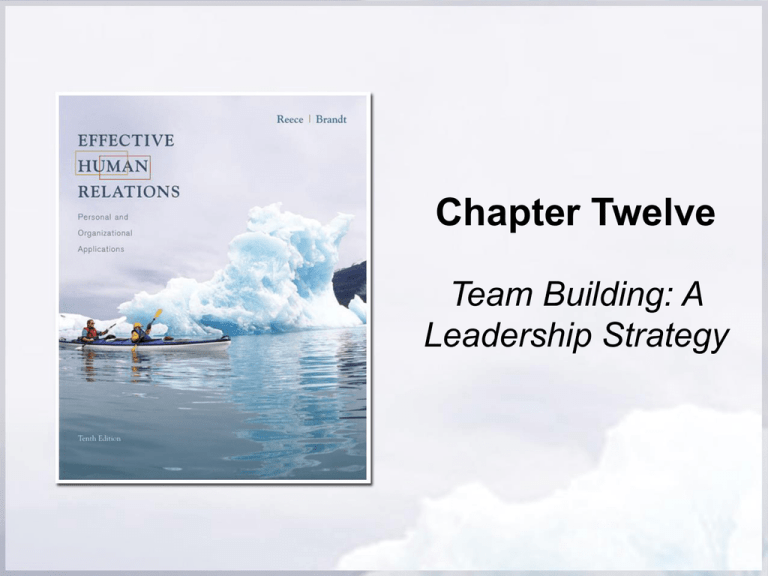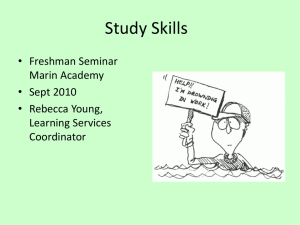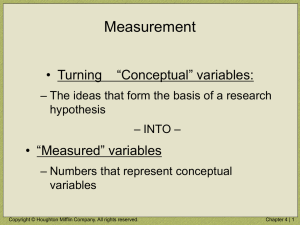
Chapter Twelve
Team Building: A
Leadership Strategy
Chapter Preview: Team Building—
A Leadership Strategy
• Teamwork in an organizational setting
• Common types of work teams
• Characteristics of an effective work
team
• Behavioral science principles that
support team building
• Team-building skills leaders need
• Team-member skills employees need
Copyright © Houghton Mifflin Company. All rights reserved.
12 | 2
Leadership Challenges in a Changing
Workplace
• Rapid changes and demand for
increased productivity
• Greater employee stress and tension
• Long-term strategies versus short-term
demands
• Increased diversity
• Employment stability
Copyright © Houghton Mifflin Company. All rights reserved.
12 | 3
Team Building: An Introduction
• Most organizations are trying to develop
a spirit of teamwork
• Leadership style that promotes team
building is positively associated with
– Productivity
– Profitability
Copyright © Houghton Mifflin Company. All rights reserved.
12 | 4
Team Building: An Introduction
• Teamwork
– Job gets done efficiently and harmoniously
– Fewer interpersonal relations problems
– Positive effect on the physical and
psychological well-being of employees
– Higher levels of job satisfaction and less
stress
Copyright © Houghton Mifflin Company. All rights reserved.
12 | 5
Team Building: An Introduction
• Synergy is another positive outcome of
teamwork
– The interaction of two or more parts to
produce greater results than the sum of the
parts taken individually
• Especially important when organizations
value creativity
Copyright © Houghton Mifflin Company. All rights reserved.
12 | 6
Teamwork Doesn’t Come Naturally
• Most jobs today require ongoing
interaction between coworkers and
managers
• Requires meaningful employee
participation in planning, solving
problems, and developing ways to
improve the organization
• Teamwork flourishes under strong
leadership
Copyright © Houghton Mifflin Company. All rights reserved.
12 | 7
The Transition to Team-Based
Structures
• Teams have become popular because
they effectively reduce costs, foster
innovation, and improve quality
• There are two common types of teams
– Self-managed
– Cross-functional
Copyright © Houghton Mifflin Company. All rights reserved.
12 | 8
Self-Managed Teams
• Assume responsibility for traditional
management tasks as part of regular
work routine
• Increases accountability
• Reduces time on dull and repetitive
tasks
• Taps employees full potential
Copyright © Houghton Mifflin Company. All rights reserved.
12 | 9
Cross-Functional Teams
• Task groups are staffed with a mix of
specialists who are focused on a
common objective
• Involve developing new work
procedures or products, devising work
reforms, or introducing new technology
• Often make decisions that directly
influence improvements
Copyright © Houghton Mifflin Company. All rights reserved.
12 | 10
Teams Take Time to Develop
• Using teams is not a quick fix
– Can take one or two years for members to
learn all the tasks
– Takes time for team to become comfortable
making decisions, scheduling work, hiring,
training, and problem solving
• Team effectiveness determinants
– People-related factors
– Organization-related factors
– Task-related factors
Copyright © Houghton Mifflin Company. All rights reserved.
12 | 11
Basic Beliefs About Teamwork
• One Approach
– Examine careers of successful leaders
who demonstrate ability to develop
teamwork
• A Second Approach
– Review the findings of scholars who have
identified the characteristics of successful
leaders
Copyright © Houghton Mifflin Company. All rights reserved.
12 | 12
McGregor’s Influence
• Emphasized “unity of purpose” as the
main feature of productive work units
• Suggests several characteristics of an
effective work team
– Informal and relaxed atmosphere
– They discuss work-related issues and have
comfortable disagreements
– Tasks and objectives are well understood
– Members listen to each other
– People freely express feelings and ideas
Copyright © Houghton Mifflin Company. All rights reserved.
12 | 13
Total Person Insight
The day soldiers stop bringing you their
problems is the day you have stopped
leading them. They have either lost
confidence that you can help them or
concluded that you do not care. Either
case is a failure of leadership.
General Colin Powell (Ret.)
United States Army
Copyright © Houghton Mifflin Company. All rights reserved.
12 | 14
The Leadership Grid®
• The Leadership Grid® is based on two
leadership style dimensions:
– Concern for people
– Concern for productivity
• Five most important styles
– Impoverished management
– Country club management
– Authority compliance
– Middle-of-the-road management
– Team management
Copyright © Houghton Mifflin Company. All rights reserved.
12 | 15
The Leadership Grid®
• Team management style is most
positively associated with
– Productivity and profitability
– Career success and satisfaction
– Physical and mental health
– Shared responsibility
– High participation
– Commitment
Copyright © Houghton Mifflin Company. All rights reserved.
12 | 16
Hall’s Contributions
• High-achieving managers
– Have deep interest in both people and
productivity
– Rely heavily on participative approach
• Low/moderate-achieving managers
– Avoid involving subordinates in planning
and decision making
• Participative managers have confidence
in workers’ potential
Copyright © Houghton Mifflin Company. All rights reserved.
12 | 17
Behavioral Science Principles
•
•
•
Shared participation in problem
solving is basis for growth,
development, and contribution
Mutual trust and respect underpins
productive human relationships
Open communication supports mutual
understanding
Copyright © Houghton Mifflin Company. All rights reserved.
12 | 18
Behavioral Science Principles
•
•
Conflict management by direct
problem-solving confrontation
promotes personal health
Responsibility for one’s own actions
stimulates initiative
Copyright © Houghton Mifflin Company. All rights reserved.
12 | 19
Total Person Insight
Life is good when trust is present. Life
hurts when trust disappears. We
understand this at a level so deep it is
indistinguishable from our very being.
Michael Crom
Vice President, Dale Carnegie & Associates,
Inc.
Copyright © Houghton Mifflin Company. All rights reserved.
12 | 20
Team-Building Skills for Leaders
• Successful leaders share some
behavioral characteristics
• Two of the most important are
– Consideration
– Structure
• These dimensions are separate and
independent of each other
Copyright © Houghton Mifflin Company. All rights reserved.
12 | 21
Figure 12.2 - Basic Leadership Styles
from the Ohio State Study
Copyright © Houghton Mifflin Company. All rights reserved.
12 | 22
Consideration
• Extent to which a manager’s
relationships with workers are
characterized by
– Mutual trust
– Respect for employees
– Consideration of feelings
– Warmth in interpersonal relationships
– Good rapport
– Two-way communication
Copyright © Houghton Mifflin Company. All rights reserved.
12 | 23
Structure
• Extent to which a supervisor is likely to
direct workers toward goal attainment
• Managers actively direct activities by
– Scheduling
– Planning
– Setting goals
– Communicating information
– Evaluating performance
Copyright © Houghton Mifflin Company. All rights reserved.
12 | 24
Improving Consideration Skills
• Leaders with consideration skills follow
law of empathy
• Practices that can improve
consideration
– Recognize accomplishments
– Provide for early and frequent success
– Take a personal interest in each employee
– Establish a climate of open communication
– Discover individual employee values
Copyright © Houghton Mifflin Company. All rights reserved.
12 | 25
Improving Structure Skills
• The team builder gives the group
direction, standards and maintains
accountability
• Practices that develop structure skills
– Communicate your expectations
– Provide specific feedback often
– Deal with poor performance immediately
– Coach for peak performance
Copyright © Houghton Mifflin Company. All rights reserved.
12 | 26
Situational Leadership
• Theory that most effective leadership
occurs when leader’s style matches the
situation
• Emphasizes the need for flexibility
• Two dimensions
– Task behavior
– Relationship behavior
Copyright © Houghton Mifflin Company. All rights reserved.
12 | 27
Model Similarities
Relationship behavior
• Consideration
• Concern for people
Task Behavior
• Structure
• Concern for production
Copyright © Houghton Mifflin Company. All rights reserved.
12 | 28
Model Differences
When attempting to influence others:
• Diagnose readiness level in the
follower for specific task
• Provide appropriate leadership style
for that situation
Copyright © Houghton Mifflin Company. All rights reserved.
12 | 29
Total Person Insight
…the most effective leaders are alike in
one crucial way: They all have a high
degree of what has come to be known
as emotional intelligence.
Daniel Goleman
Author, Working With Emotional Intelligence
Copyright © Houghton Mifflin Company. All rights reserved.
12 | 30
Figure 12.4 – Additional
Leadership Qualities
Copyright © Houghton Mifflin Company. All rights reserved.
12 | 31
Additional Leadership Qualities
• Character-- personal standards of
behavior including honesty, integrity,
and moral strength
• Impossible to build trusting relationships
without character
• Emotional intelligence-- Ability to
monitor your own and others’ emotions
and deal with them effectively
Copyright © Houghton Mifflin Company. All rights reserved.
12 | 32
Teamwork: The Employee’s Role
• Most valued employees are willing to
assume leadership roles and
responsibilities
• Each team member should
– Assume an active part in helping the work
unit achieve its mission
– Be a team builder
Copyright © Houghton Mifflin Company. All rights reserved.
12 | 33
Employees as Leaders
• Effective leaders help work team
members develop leadership skills
• The team’s success does not always
ride on one person
• There is merit in establishing a diversity
of leadership within the work group
Copyright © Houghton Mifflin Company. All rights reserved.
12 | 34
Becoming a Valued Team Member
• Avoid becoming part of a clique or
subgroup within the team
• Avoid any action that might sabotage
the team
• Keep in mind that effective team
membership depends on honest, open
communication
• Do not feel the need to submerge your
own strong believes, creative solutions,
and ideas
Copyright © Houghton Mifflin Company. All rights reserved.
12 | 35
Total Person Insight
Great challenges require great teamwork,
and the quality most needed among
teammates amid the pressure of a difficult
challenge is collaboration….Each person
brings something to the table that adds value
to the relationship and synergy to the team.
John C. Maxwell
Author, The 17 Essential Qualities of a Team Player
Copyright © Houghton Mifflin Company. All rights reserved.
12 | 36
Managing the Relationship with
Your Boss
• Relationships are usually more effective
when both parties assume responsibility
• Burden for managing relationships
should not fall solely on supervisor
• Supervisor will become more effective
at performing his or her job
Copyright © Houghton Mifflin Company. All rights reserved.
12 | 37
Managing the Relationship with
Your Boss
•
•
•
•
Assess your own strengths
Develop an understanding of your boss
Flex your communication style
Be frank and candid
Copyright © Houghton Mifflin Company. All rights reserved.
12 | 38
Chapter Review
• Teamwork in an organization setting
– Teamwork ensures that a job gets done
efficiently
– Successful teamwork often is the
difference between profitable and
unprofitable operations
– The team-building leadership style is suited
to most of today’s employees
Copyright © Houghton Mifflin Company. All rights reserved.
12 | 39
Chapter Review
• Common types of work teams
– Self-managed teams assume responsibility
for traditional management tasks
• Produce a well-defined product or
service
• Members usually rotate among the
various jobs
– Cross-functional teams are a mix of
specialists focused on a common objective
• Often temporary units with members
from different departments
Copyright © Houghton Mifflin Company. All rights reserved.
12 | 40
Chapter Review
• Characteristics of an effective work
team
– Effective teams tend to be informal and
relaxed
– People are involved, interested, and eager
to participate in problem solving
– Group also has clearly understood goals
and objectives
Copyright © Houghton Mifflin Company. All rights reserved.
12 | 41
Chapter Review
• Behavioral science principles that
support team building
– Two ways to learn about teams is to study
leaders who promote it and scholars who
discuss it
• McGregor
• Blake
• Mouton
• Hall
Copyright © Houghton Mifflin Company. All rights reserved.
12 | 42
Chapter Review
• Team-building skills leaders need
– Two important dimensions of supervisory
leadership
• Consideration
• Structure
– The Leadership Grid and the Situational
Leadership Model clarify these two
dimensions
– Effective leaders must also have character
and emotional intelligence
Copyright © Houghton Mifflin Company. All rights reserved.
12 | 43
Chapter Review
• Team-member skills employees need
– Effective work groups assume effective
leadership and membership roles
– Members help the group achieve its
mission
– Everyone is a team member and team
builder
– Employees give guidance and support to
their supervisor
– Most bosses need this assistance and
support to achieve success
Copyright © Houghton Mifflin Company. All rights reserved.
12 | 44







